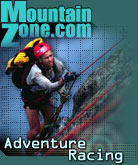
Yukon Death March
Freezing rain, mushy snow, and a new course pushed Alaska Ultra Sport racers to the limits of their endurance
Nome, Alaska - June 21, 2003
The first 30 miles was nice, smooth skate skiing and super fast riding for the cyclists who were in the race. The trail for the next 60 miles got much narrower. Pat Norwil and I were going a similar pace, although he is far stronger. We had to classic ski most of it. I had decided to carry two pairs of skis: one pair of Fischer's brand new Pacer--a micro skate ski, and one pair of old micro skate skis that had been waxed for classic skiing. The Fischers were super fast on the narrower snow machine trails.
These trails in Alaska are not the nice groomed trails that most people think of for cross-country skiing. Sometimes the trails are pretty good and easily skate-able. Other times it is hard to stay upright--off camber, uneven, brush sticking out of the ground, glare ice for miles--fun stuff. The tricky part of doing both skate and classic skiing is the difference in pole length to do each technique properly. My lightweight answer to this was Leki's new carbon adjustable Vario pole. It was a huge advantage to be able to change the length depending on fatigue, conditions, and technique.
| ||
I had about 12 pounds of gear, which included: Patagonia Das jacket, feathered friends pants, Toko and Cerax ski wax, an extra pair of gloves, Black diamond super nova headlamp, a couple of tools, splint kit in case I broke a pole, saw, camera, GPS, and a Trangia alcohol stove and pot for melting snow to make water.
I put every piece of gear to good use. Clothing for an event like this is critical for success, comfort and survival. The new soft shell technology has made racing in this environment so much easier. I wore Patagonia's new Slingshot jacket and Talus pant and never once got overheated, sweaty or cold. It's the most comfortable I have ever been in my 10-years of racing in Alaska.
Pat and I spent much of the trail into Manley ducking underbrush. At one point Pat didn't duck enough for the 200cm skis strapped to his back and a tree branch ripped them off. I gave him an extra strap and he was good as new. After 22 hours without a break we finally made it into Manley. Much to our surprise when we got there, we caught up to everyone except Eric Warkentin, who had blown through 10-hours earlier and hardly stopped before heading on to Tananna. My feet were killing me, and there was no way I could have gone straight back on to the trail without a rest.
On another creek crossing the ice looked really thin and we stopped to take a closer look. I didn't feel like taking 20 minutes to find a better crossing point so I just went for it. I broke through the ice on the second step and then waded in knee-deep, freezing water. But I was dressed for just such an occurrence and knew my feet would be fine.
—By John Stamstad at www.singletrackranch.com
